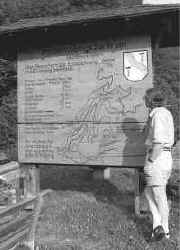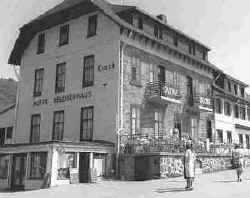THE UPPER
|
|
Harlan Hague |
The very name suggests mystery, leafy paths in dark, forbidding woods frequented by fairies and gnomes. In reality, the Black Forest is a region of picturesque villages and wooded hills, laced with hiking trails. Located in southwestern Germany near the borders of France and Switzerland, the Black Forest is 105 miles long and twenty to thirty-seven miles wide.
The central region, called the Upper Black Forest, is noted for its scenic countryside and attractive villages. The area is a popular holiday destination among Germans and other Europeans, but few Americans find their way there. Indeed, nowhere does one see many people except at a few lakeside spas.
You can get a very nice impression of the region with a one-day circular drive, beginning at the university town of Freiburg. At the beginning or end of your tour, take time to see the Romanesque-Gothic cathedral, begun in the early thirteenth century.
Climb the tower for a view of the town and westward, the range of the Vosges in France. Visit the historic buildings (Wenzingerhaus, Kaufhaus, and Archiepiscopal Palace) on the Munsterplatz just south of the cathedral, and the New Town Hall on the nearby Rathausplatz. Take time to enjoy the tree-shaded walks and the myriad of flowers in the balcony boxes.
To begin your journey, drive north from Freiburg to Waldkirch. Visit the old section around the church of St. Margaret. For a panoramic view of the region, continue on the road past the church to Kandel peak.
On the main road again, drive eastward through the lovely little villages of St. Margen and St. Peter. Each has a historic Baroque church. Farther on the road, you reach Titisee, a charming lakeside resort where tourists on sunny days crowd the shops and sidewalk stalls and lie on the sandy beach. There are paddle boats for rent. This is a nice spot for a morning coffee at an outdoor cafe.
The road now climbs to Kappel, a pretty village with an interesting church and a view of the countryside. Drive a bit higher before dropping down to Schluchsee, the largest lake in the Black Forest and a pleasant resort town. Drive on and soon you will see the signs for Feldberg, just off the main road. From a parking area, you can take a quarter-hour chairlift ride to the famous statue of Bismark. Another quarter-hour of walking, and you arrive near the highest point in the Black Forest for a panoramic view.
A few miles down the road, at Todtnau, you must make a decision. There are two routes, equally interesting, that you can take for Freiburg. The Schauinsland Road, the main road, turns northward, following signs for Todtnauberg and Gunterstal. Be forewarned: a section of this route south of Gunterstal is famous locally for its use as a mountain auto race course. It has some hairpin curves that will test your driving skills and your companion's nerves. If you take your time, you should have no trouble, and the rewards are substantial.
If you decide to take the Schauinsland Road, pass through Todtnau and start climbing. A short distance beyond the town, you will see a sign for a waterfall (wasserfall) leading into a parking area. The trail to the fall, actually a series of falls and cascades, is in a wooded gorge and is well-marked. Don't be misled by the sign that tells you that it is a ten-minute walk. It is longer and all uphill, though not terribly strenuous.
If you prefer a nice stroll rather than a climb, drive past the parking area a few hundred yards higher until you see a refreshment kiosk on the right on a sharp curve. Park there, and take the trail just behind it. The walk to the falls is shady and mostly level.
Back on the main road, you will see signs pointing to a side road for Todtnauberg, the highest resort in the Black Forest. The setting is impressive and the village interesting, but it can be bypassed if time is a factor.
Leave at least an hour of daylight for the balance of the drive to Freiburg. It is only a few miles, but the road is winding, and you will want to stop occasionally for viewing, particularly near the summit.
The alternative drive from Todtnau, which I prefer to the Schauinsland Road, turns southward just past Todtnau, toward Utzenfeld. (If time permits, visit the pretty little town of Schonau, a few miles farther on the same road.) Just south of Utzenfeld, turn westward following signs for Belchen and Staufen.
Climbing steadily now, you shortly reach the hillside village of Aitern. This is a delightful place to spend the night if you can spare the extra day. There are a number of rustic guest houses, small hotels and homes that accommodate travelers. I favor the latter.
 At Aitern, my family and I stayed in a perfectly charming old village house. There were stacks of neatly-cut firewood in front, partially covered withcascading flowers of a half dozen varieties and hues. A balcony that ran the width of the house was protected by the deep roof overhang. Three cows were kept under the same roof in a barnlike room at the back of the house. They were driven each morning to nearby pasture and brought back each evening.
At Aitern, my family and I stayed in a perfectly charming old village house. There were stacks of neatly-cut firewood in front, partially covered withcascading flowers of a half dozen varieties and hues. A balcony that ran the width of the house was protected by the deep roof overhang. Three cows were kept under the same roof in a barnlike room at the back of the house. They were driven each morning to nearby pasture and brought back each evening.
In front of the house, an ancient horse-watering trough, carved from a three-foot diameter tree trunk, still held water. A number of like troughs and small ponds in the village were fed continuously by springs. Just across the road from my lodging, a small stream tumbled down the hillside.
We drove about two miles higher that evening for the view and stopped for dinner at a roadside gasthof. I know little German, but I tried to explain to the waitress that we would like to sit at an outside table on the terrace if that were possible. She looked at me blankly. After a moment, she said, "Are you Americans?" with no trace of accent. I replied that we were. "So am I," she said.
Amy Weinmeister was a student from Edmond, Oklahoma. She was working at the restaurant and living with the owners through a summer work-study program. The program places students in German, French and Spanish-speaking countries in living and working situations that require conversation. She chatted with us at our table on the lawn and agreed with my observation that this was certainly an idyllic classroom. All classrooms should have such a view. She was a bit lonely, however. There were few young people on the mountain.
I was surprised when she told me that we were only the second Americans to stop at the gasthof all summer. I should have thought there would be more, especially since there are so many Americans living in Germany.
Beyond Aitern, the road continues to climb. Take a turning to the left signposted for Belchen. The road ends above tree line at the Hotel Belchenhaus. A short walk behind the hotel takes you to the windswept summit. The valley of the Rhine River
 stretches out below. Westward, you can see the range of the Vosges in France, and the Swiss Alps in the south.
stretches out below. Westward, you can see the range of the Vosges in France, and the Swiss Alps in the south.
From the Belchen, the road descends to a plain of meadows and woods. Stop at St. Trudpert Abbey and walk through the grounds and see the interior of the lovely church. Drive a few miles farther to reach Staufen.
This pretty village has cobblestone streets and an interesting fountain and platz. There is a small park, with a fountain and shaded by beech trees, a nice spot for a picnic lunch. A ruined castle, dramatically situated atop a vineyard-covered hill overlooks the town and the Rhine Plain. Staufen should satisfy anyone's romantic perceptions of the Black Forest region. From Staufen, it is a short drive on a well-signposted road back to Freiburg.
For information on the Black Forest, begin by writing to the German National Tourist Office, 122 E. 42d Street, New York, NY 10168-0072, telephone 212/661-7200, or 11766 Wilshire Boulevard, Los Angeles,CA 90025, 310/575-9799. At Aitern, we stayed with Max Steiger, 7869 Aitern, telephone number 07673-350.
|
|